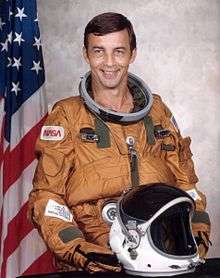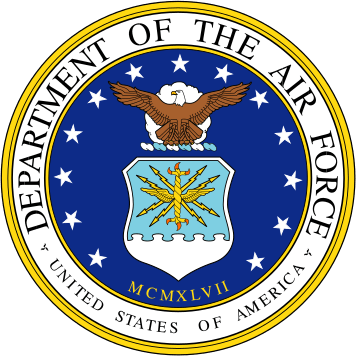Donald H. Peterson
| Donald H. Peterson | |
|---|---|
 | |
| USAF / NASA Astronaut | |
| Nationality | American |
| Status | Retired |
| Born |
October 22, 1933 Winona, Mississippi, U.S. |
Other names | Donald Herod Peterson |
Other occupation | Fighter pilot, test pilot, engineer |
|
USMA, B.S. 1955 AFIT, M.S. 1962 | |
| Rank | Colonel, USAF |
Time in space | 5 days 23 minutes |
| Selection |
1967 USAF MOL Group 3 1969 NASA Group 7 |
Total EVAs | 1 |
Total EVA time | 4 hours 17 minutes |
| Missions | STS-6 |
Mission insignia |
|
| Retirement | November 1984 |
Donald Herod Peterson (born October 22, 1933) is a retired United States Air Force officer and a former USAF and NASA astronaut.
Biography
Early life and education
He was born in Winona, Mississippi, on October 22, 1933. Peterson is married, and has three children and four grandchildren. Peterson graduated from Winona High School, Winona, Mississippi, in 1951; received a Bachelor of Science degree from the United States Military Academy at West Point, New York, in 1955, and a Master of Science degree in Nuclear Engineering from the U.S. Air Force Institute of Technology, Wright-Patterson Air Force Base, Ohio, in 1962.
USAF career
Peterson graduated from West Point in 1955. His assignments included four years as a flight instructor and military training officer with the Air Training Command, three years as a nuclear systems analyst with the Air Force Systems Command, and one year as a fighter pilot with Tactical Air Command, including three months of combat weapons training.
He is a graduate of the Aerospace Research Pilot School at Edwards Air Force Base, California, and was one of the third group of astronauts assigned to the USAF Manned Orbiting Laboratory (MOL) program.
He has logged over 5,300 hours flying time—including more than 5,000 hours in jet aircraft.
NASA career

Peterson became a NASA astronaut in September 1969 after the MOL program was cancelled. He served on the astronaut support crew for Apollo 16.
Peterson retired from the United States Air Force with the rank of colonel after having completed more than 24 years of active service, but continued his assignment as a NASA astronaut in a civilian capacity. His areas of responsibility have included engineering support, man/machine interface, and safety assessment.
Peterson was a Mission Specialist on STS-6, which launched from Kennedy Space Center, Florida, on April 4, 1983. He was accompanied by Paul J. Weitz (spacecraft commander), Col. Karol J. Bobko (Pilot), and Dr. F. Story Musgrave (Mission Specialist). During this maiden voyage of the spacecraft Challenger, the STS-6 crew conducted numerous experiments in materials processing, recorded lightning activities, deployed the first Tracking and Data Relay Satellite (TDRS-A), and activated three Getaway Specials. Peterson and Musgrave conducted an extravehicular activity (EVA), commonly called a "spacewalk," to test the new suit, the Shuttle airlock, and new tools and techniques for construction and repair outside a spacecraft. After 120 hours of orbital operations STS-6 landed on the concrete runway at Edwards Air Force Base, California, on April 9, 1983. With the completion of this flight Don Peterson has logged 4 hours 15 minutes in extravehicular activity, and a total of 120 hours in space.
Post-NASA career
Peterson resigned from the NASA Astronaut Corps in November 1984, and since that time has worked as a consultant in the area of manned aerospace operations.
Honors
He was awarded the Air Force Commendation Medal, the Meritorious Service Medal, and the JSC Group Achievement Award (1972).
References
External links
| Wikimedia Commons has media related to Donald H. Peterson. |
Peterson's official NASA biography
